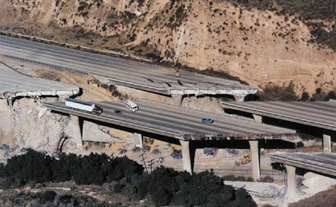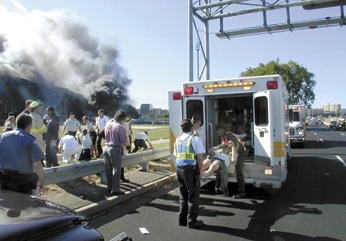| Skip
to content |
|
|
|
Emergency Transportation ResponseThis publication is an archived publication and may contain dated technical, contact, and link information.Emergency Transportation Response ChallengesDisasters can happen anywhere at any time, often without warning, and come in infinite varieties. Now we must consider terrorist attacks as well as natural disasters and incidents. Transportation is critical to emergency response. Regardless of whether transportation facilities are directly affected by the disaster, transportation is needed to bring responders to the scene, transport the ill and injured to medical facilities, and move the public away from potential harm. To achieve efficient response across the transportation network, we need information, resources, and well-understood and effective procedures that are rehearsed with other emergency responders. What We Have LearnedThe Federal Highway Administration (FHWA) studied several emergencies, including the 9/11 terrorist attacks and natural disasters such as Hurricane Floyd. The following common themes emerged. All types of security incidents have a transportation impact.
Few of the surveyed State, local, and regional emergency management plans fully integrate transportation.
Traffic impacts occur outside the incident scene and can become a separate "incident."
Traffic impacts during recovery may be more significant than during response.In New York City following 9/11:
Transportation responders are often not . . .
Future DirectionsFHWA is working with transportation agencies and their partners to improve planning and use of technology in emergency transportation operations. Eight program areas are targeted in the areas of planning and technology. Planning: Better regional and transportation operations planning, with training and exercisesGoal: Emergency management plans need to accurately reflect how transportation will work, and transportation agency emergency plans need to reflect how the emergency will be managed. The American Association of State Highway and Transportation Officials (AASHTO) has developed an emergency response plan guide.
Planning: More and better relationships, including new partners and more integrationGoal: Transportation agencies need to have effective working relationships with other responders, including police, fire, emergency medical, public health, military, and intelligence.
Technology: Use of smarter and more powerful tools to support updated proceduresGoal: Agencies need to have tools such as evacuation models and prepared traffic response scenarios in place and tested.
Technology: Using the Incident Command System (ICS) - working the way partner responders workGoal: Agencies need to understand and be ready to work with other responders at the incident scene through ICS.
Technology: Protecting the information infrastructureGoal: Agencies need to identify critical information technology resources, assess the risks, and identify and implement countermeasures.
Technology: Implementing information infrastructure on key evacuation routesGoal: Agencies should prioritize and implement intelligent infrastructure along critical evacuation routes.
Technology: Interoperable communicationsGoal: Understand and implement agency communications systems that are compatible with other modes and other responders.
Sharing experiences, lessons learned, and successful practices Goal: Agencies can learn from the experiences of others that have faced disasters.
For more information about Emergency Transportation Response, visit https://ops.fhwa.dot.gov/program_areas/enhancing-etr.htm For more information on FHWA Office of Operations activities, visit our web site at https://www.fhwa.dot.gov/operations April 2004 FHWA-OP-04-048
|
|
United States Department of Transportation - Federal Highway Administration |
||